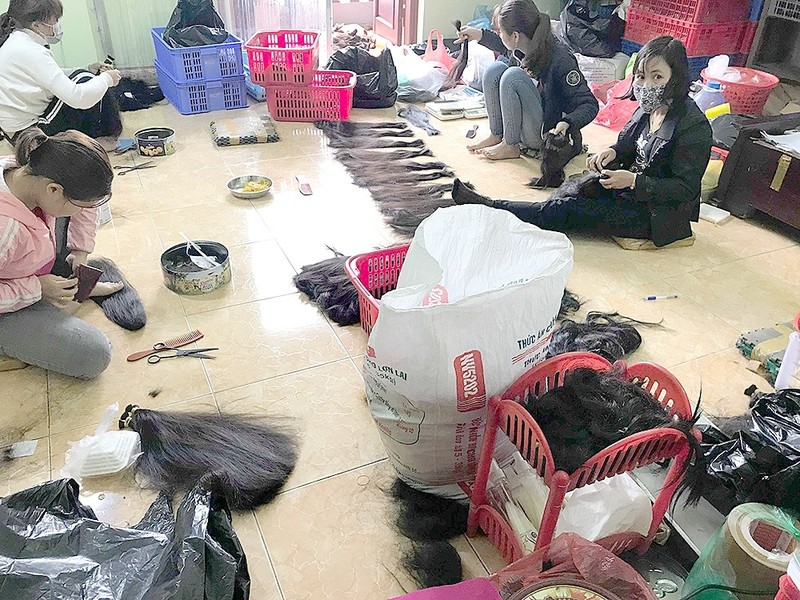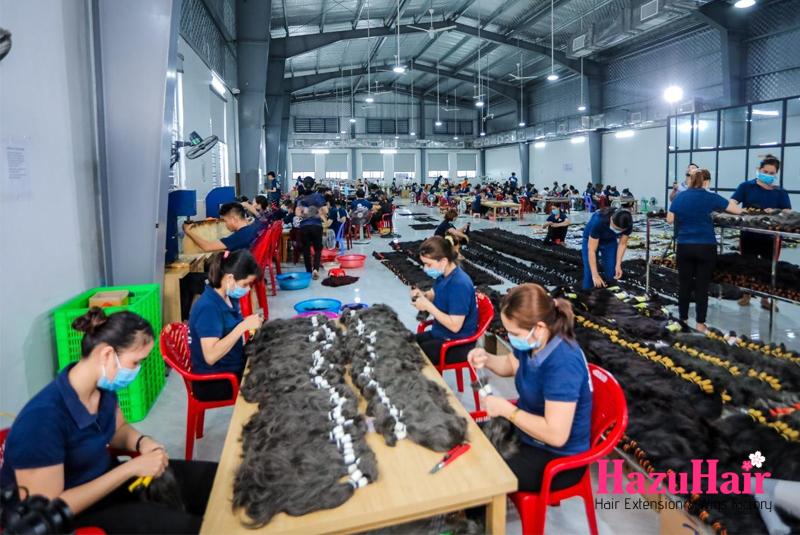News
Dong Bich, Dong Tho, Bac Ninh: Vietnam’s Hair Village Takes on the World
Nestled in Dong Tho commune, Yen Phong district, Bac Ninh province, Vietnam, Dong Bich is a small village that has carved out a big name in the global hair industry. With a population of around 5,000 residents, this rural community has become a key supplier of high-quality hair products, particularly to markets in Europe and the United States. At the heart of this industry is Hazuhair, a company with a factory in Dong Bich that has helped elevate the village’s profile. This article explores Dong Bich’s rise as a hair production hub, its economic impact, and Hazuhair’s contributions, grounded in facts and figures.
A Village Built on Hair
Dong Bich’s hair industry took root in the 1990s, a period when Vietnam began integrating into the global economy. According to local accounts, villagers initially collected and sold raw human hair to meet growing international demand. Vietnamese hair, prized for its strength, natural shine, and versatility, quickly gained traction. What began as a cottage industry has since transformed into a structured trade, with Dong Bich now hosting over 100 workshops and factories dedicated to hair processing.
Today, the village exports more than 500 tons of hair annually, generating roughly $50 million in revenue, based on industry estimates from 2023. The United States and Europe account for the bulk of these exports, with products ranging from raw hair bundles to finished wigs and extensions. Over 2,000 residents—nearly 40% of the population—are directly employed in the industry, making it the village’s economic backbone. This growth has positioned Dong Bich as a standout in Vietnam’s export landscape, a country traditionally known for textiles and electronics.

A Historical Perspective
The hair trade in Dong Bich didn’t emerge overnight. In the early years, villagers sourced hair locally, often from neighbors or nearby communities, cutting and cleaning it by hand. By the late 1990s, as word spread about the quality of Vietnamese hair, foreign buyers began approaching the village directly. This sparked a shift from informal sales to organized production, with households investing in basic equipment to process hair for export.
The industry gained momentum in the 2000s as global beauty trends fueled demand for hair extensions and wigs. Dong Bich capitalized on this, leveraging its abundant supply of raw hair and low labor costs. By 2010, the village had established itself as a reliable supplier, with businesses setting up permanent operations. The arrival of companies like Hazuhair marked a turning point, bringing modern facilities and professional standards to the trade.
Economic Transformation
The hair industry has reshaped Dong Bich’s economy. Once reliant on rice farming, the village has seen household incomes rise dramatically. Local reports suggest that average earnings have increased by 300% over the past decade, far exceeding Vietnam’s national average income growth of 6–7% annually. A typical hair worker in Dong Bich earns between $300 and $500 per month, compared to the $150 average for agricultural labor in rural areas.
This economic boost has tangible effects. Paved roads now connect Dong Bich to larger towns, replacing the dirt paths of the past. New schools and healthcare centers have opened, funded in part by local tax revenues from the hair trade. The industry employs a significant portion of women, who make up roughly 70% of the workforce, providing financial independence and shifting traditional gender roles.
Beyond direct employment, the hair boom has spurred related businesses. Logistics firms handle shipping, while packaging suppliers meet factory needs. The village has even seen a small uptick in tourism, with buyers and curious visitors stopping by to see the operations firsthand. In 2022, Dong Bich welcomed an estimated 1,000 foreign visitors, a modest but growing number.
Hazuhair: Driving Quality and Scale
Hazuhair stands out as a major player in Dong Bich’s hair industry. Founded in 2010, the company established its factory in the village to tap into the local supply chain and skilled workforce. Employing over 500 residents, Hazuhair is one of Dong Bich’s largest employers, contributing significantly to the area’s economic stability.
The company focuses on premium hair products, sourcing 100% Vietnamese human hair known for its durability and natural texture. Hazuhair’s factory in Dong Bich handles everything from sorting and cleaning to manufacturing finished goods. In 2023, the company reported revenues of $15 million, with 70% of its sales coming from the U.S. market. Its presence has not only created jobs but also raised production standards across the village, as smaller workshops adopt similar quality controls to stay competitive.
Hazuhair emphasizes ethical practices, ensuring hair is collected voluntarily from donors who are paid fair rates—typically $10 to $50 per bundle, depending on length and quality. This approach contrasts with some global suppliers criticized for exploitative sourcing, giving Hazuhair a reputational edge.

Hazuhair’s Product Line
Hazuhair offers a broad range of hair products tailored to international tastes. Its catalog includes:
- Hair Extensions: Clip-ins, tape-ins, and sew-ins, available in lengths from 12 to 30 inches. Prices start at $50 per bundle, targeting mid- to high-end consumers.
- Wigs: Both human hair and synthetic options, with human hair wigs priced between $100 and $300 depending on style and density.
- Weaves: Bulk hair for braiding or custom installations, a popular choice for salons.
Quality is a cornerstone of Hazuhair’s brand. Each product undergoes a multi-step process: hair is washed, detangled, and inspected for consistency before being dyed or styled. The company offers over 20 color options, from natural black to vibrant blondes, and textures ranging from straight to curly. This variety caters to diverse markets, particularly in the U.S., where demand for customizable hair solutions is high.
Hazuhair also prioritizes sustainability. Its Dong Bich factory uses water recycling systems to minimize waste during processing, and excess hair clippings are repurposed for lower-grade products. These efforts align with growing consumer demand for eco-friendly goods, enhancing the company’s appeal.

Challenges Facing the Industry
Dong Bich’s hair industry isn’t without hurdles. Maintaining quality as production scales is a persistent concern. With demand pushing output higher, some workshops struggle to meet the strict standards expected by Western buyers. Defective products—like tangled or shedding hair—can damage the village’s reputation if not addressed.
Competition is another issue. India and China dominate the global hair market, exporting over 1,000 tons annually combined, dwarfing Vietnam’s output. Dong Bich must differentiate itself through quality and reliability to hold its niche. For Hazuhair, this means investing in technology and training to stay ahead.
Sourcing raw hair poses a long-term challenge. As more villagers cut their hair for profit, the local supply has tightened. Hazuhair and others now source from across Vietnam, raising costs and complicating logistics. Ensuring ethical collection remains critical, as any hint of coercion could alienate customers.

Opportunities for Growth
The future looks promising for Dong Bich. The global hair extension market is expected to hit $10 billion by 2025, according to industry forecasts, driven by beauty trends and social media influence. Vietnam’s share of this market, currently around 5%, could grow if villages like Dong Bich expand capacity.
E-commerce offers a direct path to consumers. Hazuhair has already launched an online store, cutting out middlemen and boosting margins. In 2023, online sales accounted for 20% of its revenue, a figure likely to rise as digital platforms gain traction. Smaller producers in Dong Bich could follow suit, leveraging affordable tech to reach global buyers.
Innovation is another avenue. Hazuhair is exploring lightweight synthetic blends to complement its human hair line, targeting budget-conscious shoppers. Meanwhile, the village could attract more investment—perhaps a second major factory—to scale operations and create jobs.
A Global Player in the Making
Dong Bich is a case study in how a small community can punch above its weight. From a farming village to a hair industry hub, it has transformed itself in three decades, lifting living standards and gaining international recognition. Hazuhair’s factory has been a catalyst, blending local expertise with modern efficiency to produce goods that compete worldwide.
With exports to over 20 countries and a workforce dedicated to quality, Dong Bich is poised to remain a vital link in the global beauty supply chain. As demand for hair products grows, this Vietnamese village—and companies like Hazuhair—will continue to shape trends, proving that even the smallest places can leave a lasting mark.
Source:
https://kienthuc.net.vn/kinh-doanh/ngoi-lang-viet-nam-noi-tieng-au-my-nho-mon-hang-doc-1201811.html
https://vietnamnet.vn/ngoi-lang-viet-nam-noi-tieng-au-my-nho-mon-hang-doc-515622.html
